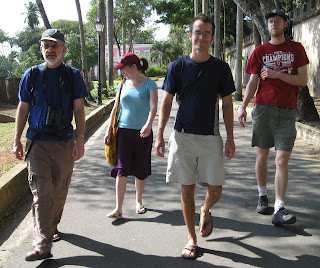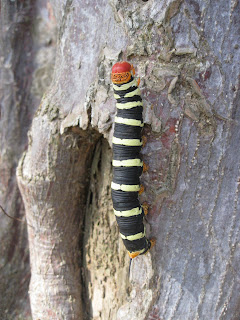Photos and text by Sally Kneidel, PhD
I went to Puerto Rico in March 2010 with my family, to visit my son Alan.
My family in San Juan: Ken, Sadie, Alan, and Matt
Alan is temporarily living in Puerto Rico, doing bird research for NC State. He and his team are studying the use of natural corridors by birds nesting in forest fragments.
Alan with lizard (lizards are abundant in P.R.)
Corridors help wildlife, in fragmented forests
This Puerto Rican research has broad implications for all fragmented bird habitat. Many of the world's forests persist only in fragments now, due to human activities such as logging, agriculture, and development. Alan is studying whether the breeding birds of Puerto Rico must have forested corridors in order to move from forest fragment to forest fragment to search for mates or food. The team is also investigating which migratory bird species pass through Puerto Rico on their way to North America from wintering grounds in Latin America.
The heritage and culture of Puerto Rico
Since Puerto Rico was colonized by the Spanish in the 1500s, almost everyone speaks Spanish as their first language. I've read that the people of P.R. are varying blends of Spanish, indigenous Taino, and Africans brought in by the Spanish. Alan says that in his home area of Guanica, on the SW coast of P.R., many of the locals are descended from Venezuelans.
Puerto Rico is different from other Latin American countries I've visited in that a huge portion of the population speaks excellent English, especially in the cities.
American stores everywhere
Another difference was the American infrastructure. The major highways were in excellent shape with highway signs that looked American, except the words were Spanish. And American stores were everywhere: Walmart, Walgreens, McDonalds, KFC, K-Mart, and more. Alan says you can find almost any American product, from an American store. Although he says a few things are way more expensive than in the U.S., which is typical of islands.
What is Puerto Rico to the U.S.?
Puerto Rico's political status is a little confusing. It's an "unincorporated territory" of the United States - belonging to the U.S. but not a part of the U.S. Federal law applies in P.R., but they have no representation in Congress. Puerto Ricans are U.S. citizens, but oddly, they can't vote in U.S. elections while in Puerto Rico. They can, however, vote if they are in the U.S. during the time of an election. Strange.
Puerto Rico doesn't want to be a U.S. state
I was told while I was there that the vast majority of Puerto Ricans do not want statehood. In fact, there was a 1950 revolt against the U.S. in the Puerto Rican town of Jayuya, known as the "Jayuya uprising." It led to the U.S. attacking Jayuya with bombers. My family stayed in Jayuya for three days on this trip - I'll write more about that in a later post. Some of the people of Jayuya were not especially welcoming of our gang of gringos from the U.S. We never did find any restaurants open, and ate dinner every night on the balcony of our hotel.
Historic, colorful, steep: Old San Juan is beautiful
The capital city of San Juan is the second-oldest European settlement in the Americas. It was founded by the Spanish in 1581, and still has two huge fortresses built by the Spanish. The ocean is almost always visible from the old part of the city, with cruise ships anchored off shore. Cruise-ship passengers roam the narrow and hilly streets, past historic pastel homes and shops.
Above, many of the steep streets in Old San Juan are paved with blue cobblestones, still in place from the Spanish colonists in the 1500s. Photo by Sally Kneidel.
Above, the buildings in Old San Juan are charming. Photo by Sally Kneidel
More Old San Juan. Photo by Sally Kneidel
Ken and Alan wait for me on a corner in Old San Juan. Photo by Sally Kneidel.
The coastal boardwalk was cool
We visited one of the two Spanish fortresses (Castillo de San Felipe del Morro) built in the 1500s, then walked back through Old San Juan along a boardwalk (or sidewalk) by the ocean. That was my favorite part of the day.
Leaving the walls of the fortress behind, setting out on the sidewalk by the sea. Photo by Sally Kneidel
A Puerto Rican family resting under a very odd tree, along the ocean walkway.
We passed a brown pelican in a tree. Photo by Sally Kneidel.
This huge striped caterpillar was perched on a strangler-fig tree. Alan and I both had to photograph it. Photo by Sally Kneidel
The caterpillar. I have no idea what kind of butterfly or moth it was. Photo by Sally Kneidel.
On to the tropical rainforest
By 3:30 pm, we had to blast out of San Juan in our rental car to get to our next destination by sundown. We headed out for El Yunque Caribbean National Forest, a mountainous rainforest. We couldn't wait to get there. It would be cooler in the mountains, and we were eager to immerse ourselves in tropical nature. That's my next post on Puerto Rico, comin' up.
Sources and additional info:
Suzanne Van Atten. Puerto Rico. Moon Handbooks. September 2009. We took this book on our trip and it was helpful. We also had Lonely Planet, but I think this one was better.
Puerto Rico. Wikipedia. This entry has a lot of info about what it means to be a territory of the U.S., and the connection between the U.S. and P.R.
Goodbye, me (Alan Kneidel's blog). Alan has a lot of posts about life in Puerto Rico.
Key words: Sally Kneidel Puerto Rico Old San Juan Caribbean bird research Alan Kneidel wildlife corridors forest fragments
Sources and additional info:
Suzanne Van Atten. Puerto Rico. Moon Handbooks. September 2009. We took this book on our trip and it was helpful. We also had Lonely Planet, but I think this one was better.
Puerto Rico. Wikipedia. This entry has a lot of info about what it means to be a territory of the U.S., and the connection between the U.S. and P.R.
Goodbye, me (Alan Kneidel's blog). Alan has a lot of posts about life in Puerto Rico.
Key words: Sally Kneidel Puerto Rico Old San Juan Caribbean bird research Alan Kneidel wildlife corridors forest fragments



















3 comments:
You have the most beautiful and intellectually impressive blog I have ever seen.
And I've seen quite a few.
May I blogroll you? I'd like to share your wisdom and the beauty of your vision with my readers.
Suzan
_____________
Thank you Suzan! Of course you can blogroll me. I would appreciate that.
About Puerto Ricans being a mixture of Spanish, Taino, and African is a shop worn cliché spread by a few Puerto Ricans who obviously can't trace their own family histories. The fact is that Puerto Rico was populated by most Europeans of Catholic background during the 18th, and 19th centuries, and those include the French, Germans, Catalonians, Corsicans, Italians, and Irish. last names like Rocher, Olivieri, Bochetti, Beauchamp, or Betancourt, just to name a few, are neither Spanish, Taino, or African.
Post a Comment